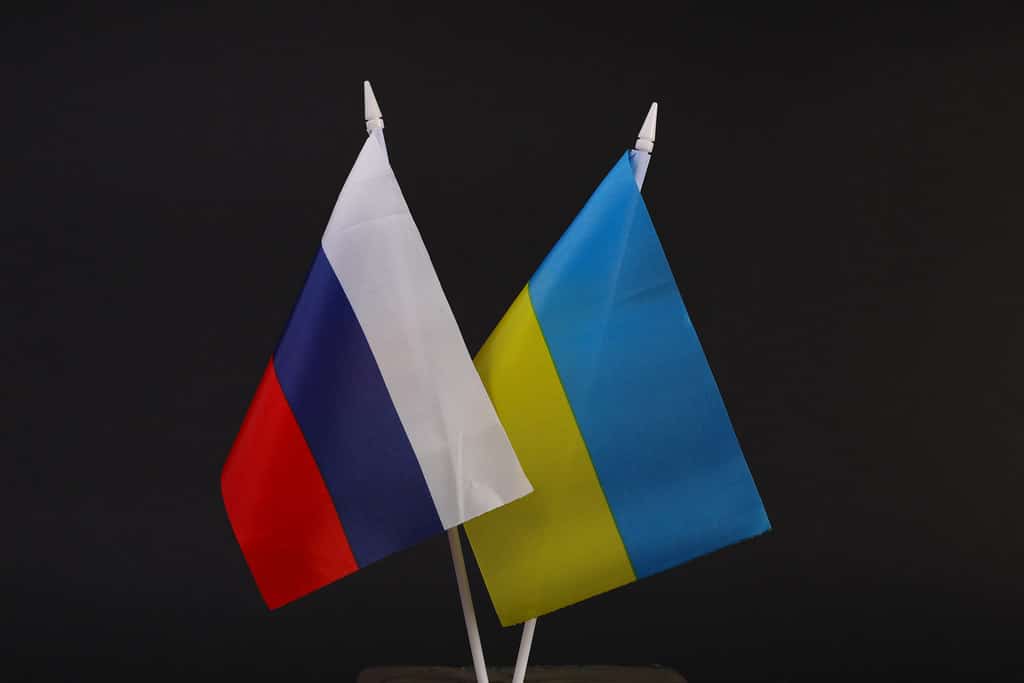Devastation has unfolded in Ukraine. As former Secretary of State Condoleezza Rice and former Secretary of Defense Robert Gates say in The Washington Post, Ukraine’s “economy is in a shambles, millions of its people have fled, its infrastructure is being destroyed, and much of its mineral wealth, industrial capacity and considerable agricultural land are under Russian control.”
As of January 23, almost 8 million people, or around 19% of the population, have fled Ukraine for Europe.
So many Ukrainian soldiers have died that a Ukrainian commander in Bakhmut, where the fighting is at its heaviest, said that “the exchange rate of trading our lives for theirs favors the Russians. If this goes on like this, we could run out.” Estimates of the number of Ukrainian soldiers killed range from over 300 to nearly 450 a day. Der Spiegel reports that German intelligence is “alarmed” by the “high losses suffered by the Ukrainian army” in the battle for Bakhmut. They told German politicians in a secret meeting that the loss of life for Ukrainian soldiers is in “three-digit number[s]” every day on that battleground alone.
What is so sad is that there were so many missed opportunities to avoid this suffering. The biggest was the opportunity missed by Russia to continue to pursue a resolution to their security concerns in a theater other than war. But there were opportunities that were missed both before and after that biggest of missed opportunities. Sadly, there were at least six.
Minsk: Not Pushing Poroshenko
Negotiated in 2014 and 2015, the Minsk agreements represented the best opportunity for peace between Russia and Ukraine. The Minsk agreements were brokered by France and Germany, agreed to by Ukraine and Russia, and accepted by the United States and United Nations. They promised to peacefully return the Donbas to Ukraine while granting it full autonomy.
But Pyotr Poroshenko, the Ukrainian president who negotiated it, said that “he had known that it would never be implemented because neither the political establishment nor public opinion in Ukraine would accept it,” according to Putin biographer Philip Short. Though they had brokered the agreement, Germany did not push Poroshenko to implement it. According to Fedor Lukyanov, professor at the National Research University Higher School of Economics in Moscow, “It was then said on the sidelines that Merkel actually did not advise Poroshenko to sign the proposed text.” Though the U.S. officially accepted the Minsk agreements, they never did anything to encourage or force their implementation. There have also been reports that “the U.S., the only party who could have really pressured [Poroshenko], told him not to follow up on the agreement.”
The first opportunity was lost when Poroshenko never implemented the Minks agreements. The U.S. never pushed him toward the diplomatic solution and may have even subtly encouraged the military alternative. On the heels of the signing of the agreements, by March 2015 the Obama administration had sent $75 million of defensive military aid to Ukraine. By April, hundreds of American, British, and Canadian military trainers were in Ukraine.
Minsk: Not Supporting Zelensky
In 2019, Zelensky was elected in large part because his platform of making peace with Russia and signing the Minsk II Agreement won him the Russian speaking vote in the south and east. But to fulfill his promise, Zelensky had to have the support of the U.S. He didn’t get it.
Pushed off the path of diplomacy by ultranationalist elements in Ukraine, Zelensky reversed his campaign pledge and refused to implement the agreement. The U.S. then failed to pressure him back onto the road of diplomacy. Richard Sakwa, Professor of Russian and European Politics at Kent, told me that “As for Minsk, neither the U.S. nor the EU put serious pressure on Kiev to fulfil its part of the agreement.” Anatol Lieven of the Quincy Institute for Responsible Statecraft agrees. Though the U.S. officially endorsed Minsk, Lieven told me that “they did nothing to push Ukraine into actually implementing it.”
By the end of 2021, according to Nicolai Petro, the Minsk agreements were “explicitly rejected by senior Ukrainian government officials.”
When first elected, Zelensky seems to have been sincere about keeping his campaign promise to implement Minsk. Upon being elected, Zelensky told reporters that he would “reboot” peace talks with separatists in Donbas. He told them that “we will continue in the direction of the Minsk [peace] talks and head towards concluding a ceasefire.” On October 1, 2019, Zelensky signed the German and French brokered Steinmeier Formula that called for elections in Donbas and recognition of their autonomy.
Being forcefully pushed off the path of diplomacy, Zelensky was abandoned by the U.S. Again, the U.S. may have done the opposite of supporting diplomacy. Reporting on the signing of the Steinmeier Formula, Foreign Policy said that “U.S. officials have pushed for the reinstatement of Ukrainian control of its international border” and for “a tougher stance on Russia’s annexation of parts of Ukraine.”
The second opportunity was lost when the U.S. failed to support Zelensky, which was a second opportunity to prevent war by implementing the Minsk Agreements.
Minsk: On the Eve of War
Russia remained committed to the Minsk agreements as the only path to peace right up to the days before the war. Putin said that he was “convinced” there is “still…no alternative.”
Russian specialist Geoffrey Roberts, professor emeritus of history at University College Cork, says that in a November 13 interview, Putin “reiterated Russia’s commitment to the implementation of the Minsk agreements, saying there was no other mechanism to resolve the Donbas problem.”
Putin continued to meet with his Minsk counterparts right up to the eve of the war. On August 20, 2021, Putin complained to Merkel that “Ukraine has adopted a number of laws and regulations that essentially contradict the Minsk agreements. It is as if the leadership of that country has decided to give up on achieving a peaceful settlement.” Roberts reports that Putin spoke with Macron on February 12 and complained of the West’s failure to prompt Kiev to implement the agreements. The next day he told German Chancellor Olaf Scholz that he believed a solution within the Minsk agreements was still possible but that Germany and France had to pressure Ukraine. That was nine days before Russia made the decision to invade Ukraine.
Though the key players in the Minsk negotiations—France, Germany, Russia. and Ukraine—met in the days before the war, “it was clear,” Richard Sakwa says, “that Ukraine was in no mood to fulfill the Minsk-2 agreement.” It was clear, too, that the U.S. and Europe did nothing to pressure them. Putin complained to both Macron and Scholz that the West had failed to pressure them.
That was the third and final missed opportunity on Minsk. The Minsk agreements were now dead.
Russia’s Security Proposals
On December 17, 2021, Russia delivered proposals on security guarantees to both the U.S. and NATO. The key demands included no NATO expansion to Ukraine and no deployment of weapons or troops to Ukraine.
On January 26, the U.S. and NATO rejected Russia’s essential demand for a written guarantee that Ukraine would not join NATO. Derek Chollet, counselor to Secretary of State Antony Blinken, has admitted that the U.S. told Moscow that negotiating NATO expansion into Ukraine was never even on the table. Putin simply remarked “that fundamental Russian concerns were ignored.”
The official Russian response came on February 17, 2022. It said that the U.S. and NATO offered “no constructive answer” to Russia’s key demands. It then added that if the U.S. and NATO continued to refuse to provide Russia with “legally binding guarantees” regarding its security concerns, Russia would respond with “military-technical means.”
The last best opportunity to prevent the invasion was missed. One week later, Russia “respond[ed] with ‘military-technical means.’”
Istanbul: Discouraging Talks
In April 2022, negotiations in Istanbul produced a “tentatively agreed” upon settlement. A negotiated end to the war seemed to be within reach. Then the U.S. and the United Kingdom put a stop to it, and the war went on. From that moment on, the U.S. shared responsibility for the war.
Ukraine and Russia were ready to end the war. But the U.S. and UK pressured Ukraine not to pursue its own goals and sign an agreement that could have ended the war. They then pressured Ukraine to continue the war to fight for larger American goals.
The State Department rejected ending the war on Ukraine’s terms because “this is a war that is in many ways bigger than Russia, it’s bigger than Ukraine.” The war could have ended with Ukraine’s interests addressed. But the U.S. insisted that it continue until American interests were addressed.
British Prime Minister Boris Johnson then rushed to Kiev to tell Zelensky that Putin “should be pressured, not negotiated with.” He added that, even if Ukraine was ready to sign some agreements with Russia, the West was not.
Turkish Foreign Minister, Mevlut Cavusoglu, said in an interview that “There are countries within NATO who want the war to continue.” He said that “following the NATO foreign ministers’ meeting, it was the impression that…there are those within the NATO member states that want the war to continue, let the war continue and Russia get weaker.”
The first missed opportunity to stop the war came in the early days. Russia and Ukraine had reached a tentative agreement that satisfied their interests. But they did not satisfy the interests of the United States. The war now raged on in pursuit of U.S. goals.
Inflection Point: the Missed Window
In November, the war reached what military analysts call an inflection point. Ukraine’s military gains seemed to have reached an apex at which point continued fighting might lead to no further territorial gains for Ukraine but possible territorial losses to Russia. Some military analysts suggested that Kherson was likely the last Russian held ground that Ukraine will be able to retake in the foreseeable future.
The Biden administration had long said that the goal was to put Ukraine in the best possible position “on the battlefield” to “be in the strongest possible position at the negotiating table.” That time seemed to have arrived. The German and French militaries began to believe that “parity will not last long and that now is the optimal time for Ukraine to start talking.” On November 9, Chairman of the Joint Chiefs of Staff Gen. Mark Milley said, “There has to be a mutual recognition that a military victory is probably, in the true sense of the word is maybe not achievable through military means,” adding, “and therefore you need to turn to other means.”
Ukraine was at the best possible position on the battlefield to be in the best possible position at the negotiating table. And the West was at a fork in the road. They could now exert pressure on Ukraine to turn to negotiations. Or they could resolve the problem of Ukraine getting as far as they could with the weapons they had by providing them with heavier more advanced weapons.
The U.S. missed the opportunity to escort Ukraine to the negotiating table. Instead, they chose the weapons route and sent Bradleys and Strykers and tanks.
That was the most recent of the six missed opportunities to avoid or end the tragedy unfolding in Ukraine.
































